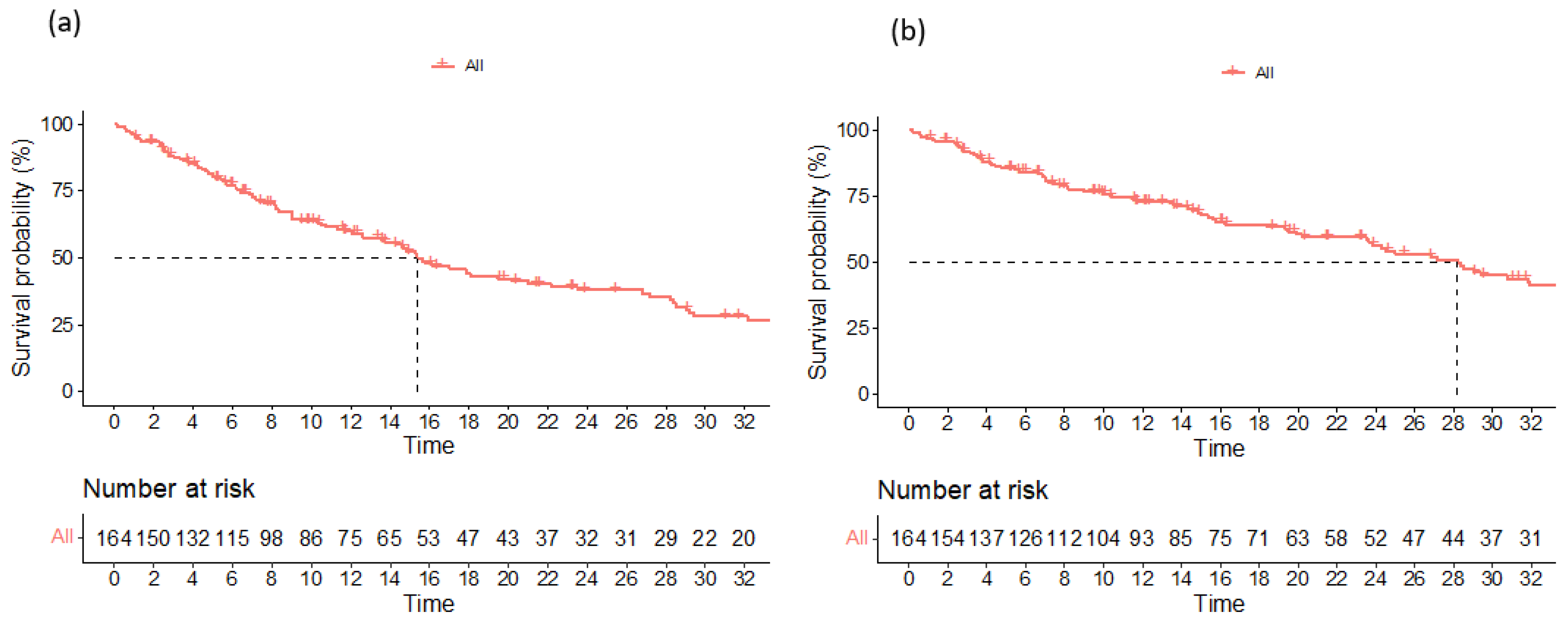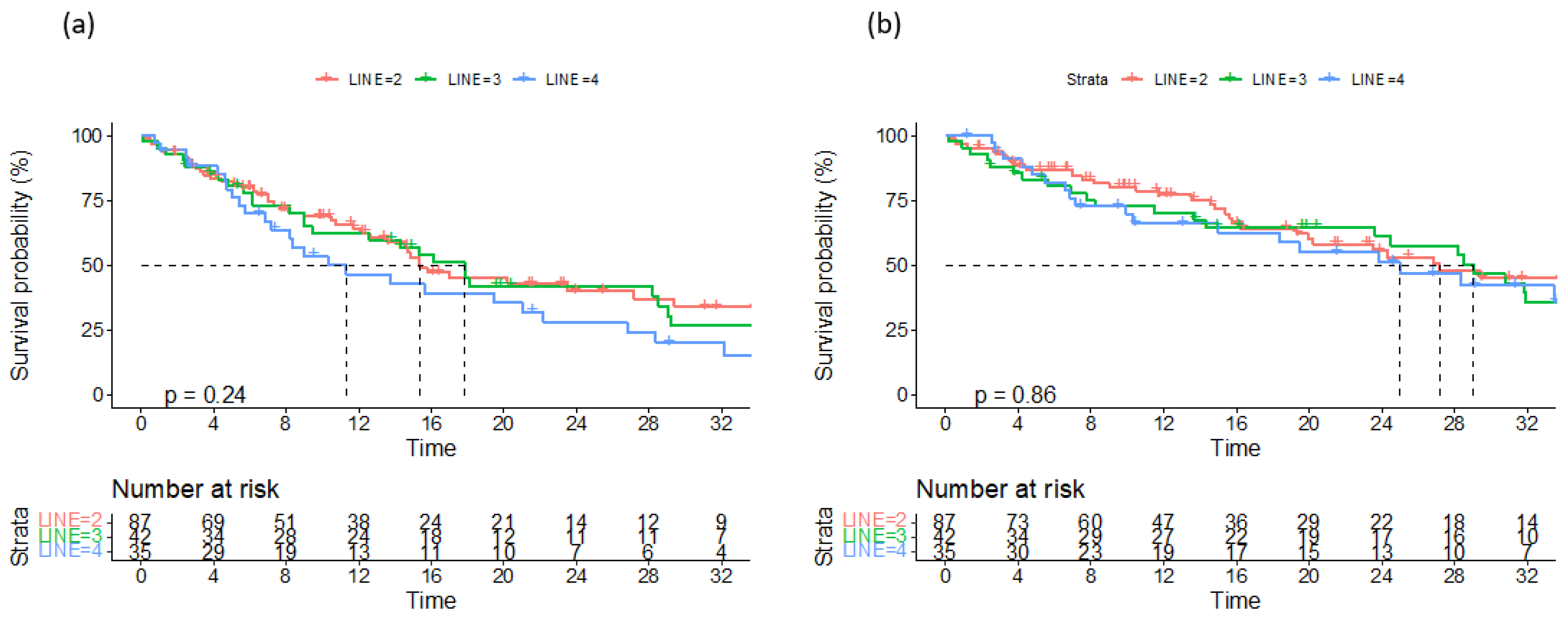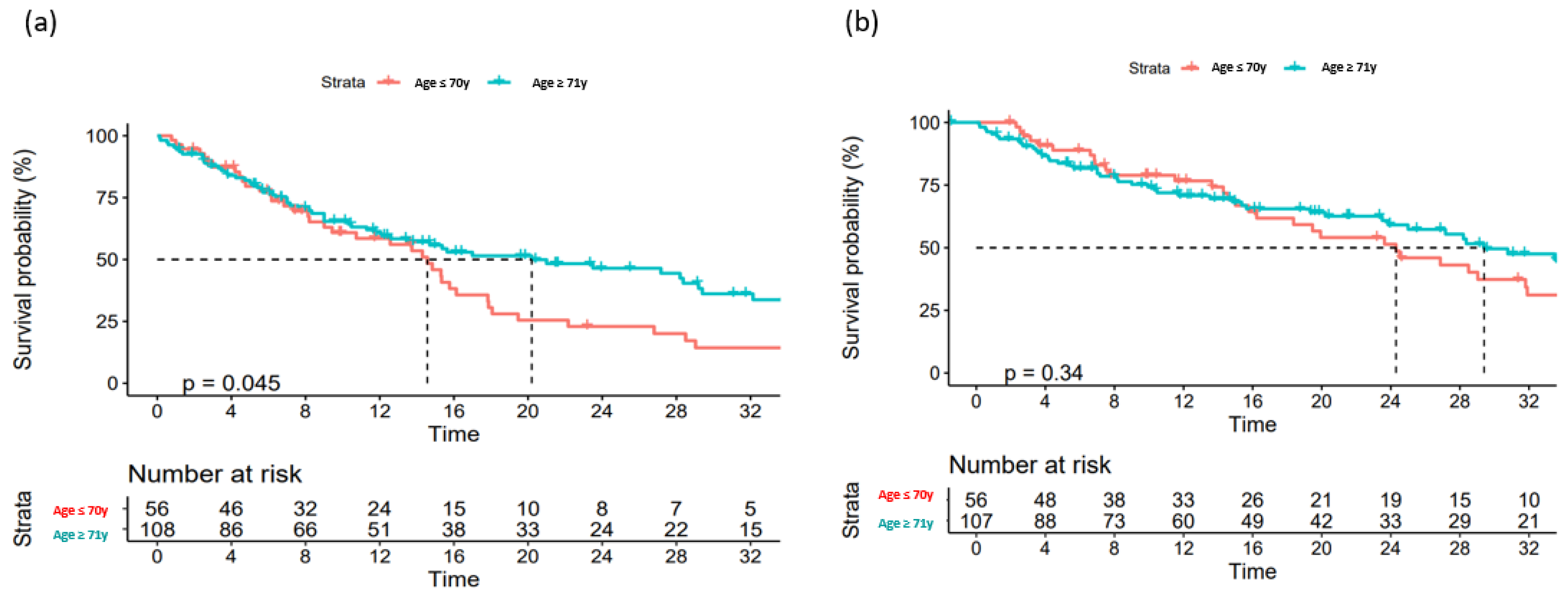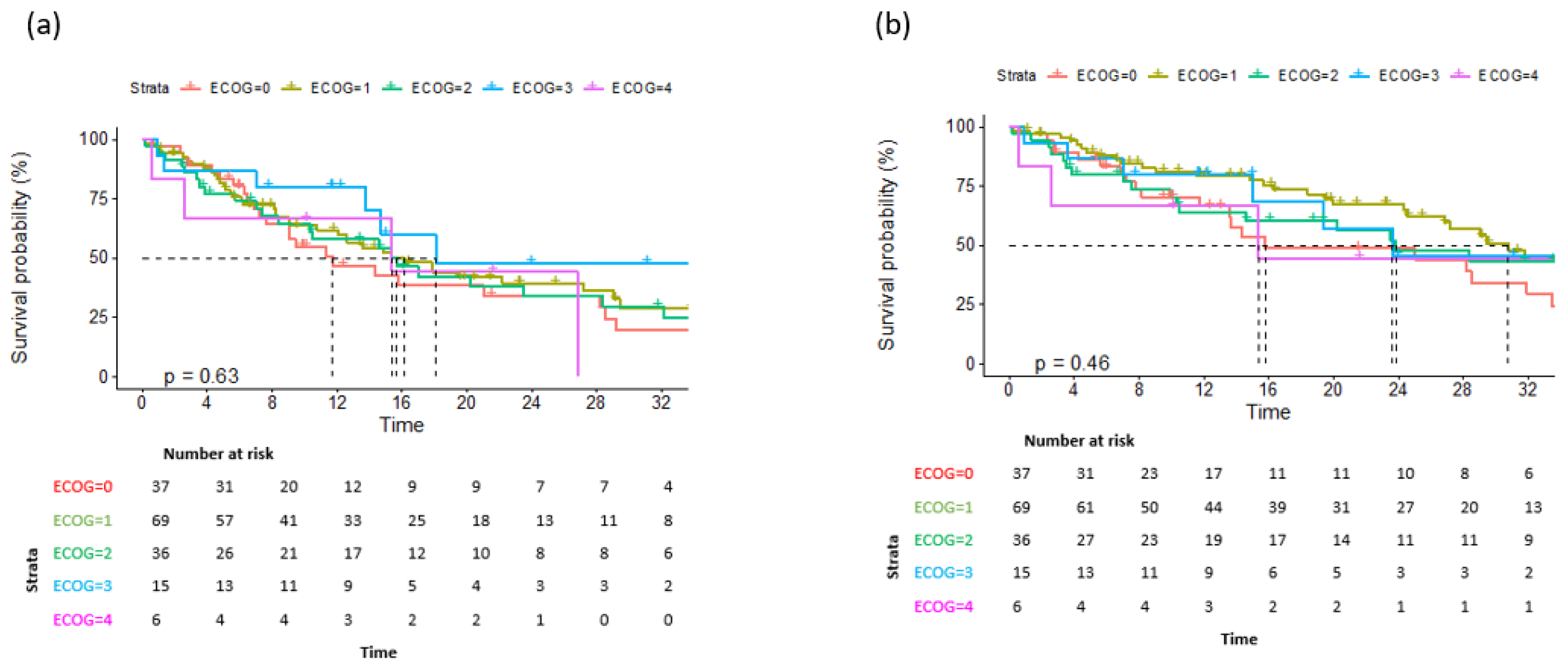Outcomes of Ixazomib Treatment in Relapsed and Refractory Multiple Myeloma: Insights from Croatian Cooperative Group for Hematologic Diseases (KROHEM)
Abstract
1. Introduction
2. Materials and Methods
Statistics
3. Results
4. Discussion
5. Conclusions
Author Contributions
Funding
Institutional Review Board Statement
Informed Consent Statement
Data Availability Statement
Conflicts of Interest
References
- Anderson, K.C. Progress and Paradigms in Multiple Myeloma. Clin. Cancer Res. 2016, 22, 5419–5427. [Google Scholar] [CrossRef] [PubMed]
- Boudreault, J.S.; Touzeau, C.; Moreau, P. Triplet combinations in relapsed/refractory myeloma: Update on recent phase 3 trials. Expert Rev. Hematol. 2017, 10, 207–215. [Google Scholar] [CrossRef] [PubMed]
- Dimopoulos, M.A.; Moreau, P.; Terpos, E.; Mateos, M.V.; Zweegman, S.; Cook, G.; Delforge, M.; Hájek, R.; Schjesvold, F.; Cavo, M.; et al. Multiple myeloma: EHA-ESMO Clinical Practice Guidelines for diagnosis, treatment and follow-up. Ann. Oncol. 2021, 32, 309–322, Erratum in Ann Oncol. 2022, 33, 117. [Google Scholar] [CrossRef] [PubMed]
- Moreau, P.; Masszi, T.; Grzasko, N.; Bahlis, N.J.; Hansson, M.; Pour, L.; Sandhu, I.; Ganly, P.; Baker, B.W.; Jackson, S.R.; et al. Oral Ixazomib, Lenalidomide, and Dexamethasone for Multiple Myeloma. N. Engl. J. Med. 2016, 374, 1621–1634. [Google Scholar] [CrossRef] [PubMed]
- Leleu, X.; Masszi, T.; Bahlis, N.J.; Viterbo, L.; Baker, B.; Gimsing, P.; Maisnar, V.; Samoilova, O.; Rosiñol, L.; Langer, C.; et al. Patient-Reported Health-Related Quality of Life From the Phase III TOURMALINE-MM1 Study of Ixazomib-Lenalidomide-Dexamethasone Versus Placebo-Lenalidomide-Dexamethasone in Relapsed/Refractory Multiple Myeloma. Am. J. Hematol. 2018; Epub ahead of print. [Google Scholar] [CrossRef] [PubMed]
- King, A.J.; Eyre, T.; Sharpley, F.; Watson, C.; Ramasamy, K.; Willan, J. Multiple myeloma in the very elderly patient: Challenges and solutions. Clin. Interv. Aging 2016, 11, 423–435. [Google Scholar] [CrossRef] [PubMed] [PubMed Central]
- Zweegman, S.; Engelhardt, M.; Larocca, A. EHA SWG on ‘Aging and Hematology’. Elderly patients with multiple myeloma: Towards a frailty approach? Curr. Opin. Oncol. 2017, 29, 315–321. [Google Scholar] [CrossRef] [PubMed]
- Fraz, M.A.; Warraich, F.H.; Warraich, S.U.; Tariq, M.J.; Warraich, Z.; Khan, A.Y.; Usman, M.; Ijaz, A.; Tenneti, P.; Mushtaq, A.; et al. Special considerations for the treatment of multiple myeloma according to advanced age, comorbidities, frailty and organ dysfunction. Crit. Rev. Oncol. Hematol. 2019, 137, 18–26. [Google Scholar] [CrossRef] [PubMed] [PubMed Central]
- Shah, J.J.; Abonour, R.; Gasparetto, C.; Hardin, J.W.; Toomey, K.; Narang, M.; Srinivasan, S.; Kitali, A.; Zafar, F.; Flick, E.D.; et al. Analysis of Common Eligibility Criteria of Randomized Controlled Trials in Newly Diagnosed Multiple Myeloma Patients and Extrapolating Outcomes. Clin. Lymphoma Myeloma Leuk. 2017, 17, 575–583.e2. [Google Scholar] [CrossRef] [PubMed]
- Hungria, V.T.; Lee, H.C.; Abonour, R.; Rifkin, R.M.; Terpos, E.; Leleu, X.; Costello, C.L.; van Rhee, F.; Weisel, K.C.; Puig, N.; et al. Real-world (rw) multiple myeloma (mm) patients (pts) remain under-represented in clinical trials based on standard laboratory parameters and baseline characteristics: Analysis of over 3,000 pts from the insight mm global, prospective, observational study. Blood 2019, 134 (Suppl. S1), 1887. [Google Scholar] [CrossRef]
- Chari, A.; Romanus, D.; Palumbo, A.; Blazer, M.; Farrelly, E.; Raju, A.; Huang, H.; Richardson, P. Randomized Clinical Trial Representativeness and Outcomes in Real-World Patients: Comparison of 6 Hallmark Randomized Clinical Trials of Relapsed/Refractory Multiple Myeloma. Clin. Lymphoma Myeloma Leuk. 2020, 20, 8–17.e16. [Google Scholar] [CrossRef] [PubMed]
- Palumbo, A.; Bringhen, S.; Mateos, M.-V.; Larocca, A.; Facon, T.; Kumar, S.K.; Offidani, M.; McCarthy, P.; Evangelista, A.; Lonial, S.; et al. Geriatric assessment predicts survival and toxicities in elderly myeloma patients: An International Myeloma Working Group report. Blood 2015, 125, 2068–2074. [Google Scholar] [CrossRef] [PubMed] [PubMed Central]
- Hari, P.; Romanus, D.; Luptakova, K.; Blazer, M.; Yong, C.; Raju, A.; Farrelly, E.; Labotka, R.; Morrison, V.A. The impact of age and comorbidities on practice patterns and outcomes in patients with relapsed/refractory multiple myeloma in the era of novel therapies. J. Geriatr. Oncol. 2018, 9, 138–144. [Google Scholar] [CrossRef] [PubMed]
- Davies, F.; Rifkin, R.; Costello, C.; Morgan, G.; Usmani, S.; Abonour, R.; Palumbo, A.; Romanus, D.; Hajek, R.; Terpos, E.; et al. Real-world comparative effectiveness of triplets containing bortezomib (B), carfilzomib (C), daratumumab (D), or ixazomib (I) in relapsed/refractory multiple myeloma (RRMM) in the US. Ann. Hematol. 2021, 100, 2325–2337. [Google Scholar] [CrossRef] [PubMed] [PubMed Central]
- Chari, A.; Richardson, P.G.; Romanus, D.; Dimopoulos, M.A.; Sonneveld, P.; Terpos, E.; Hajek, R.; Raju, A.; Palumbo, A.; Cain, L.E.; et al. Real-world outcomes and factors impacting treatment choice in relapsed and/or refractory multiple myeloma (RRMM): A comparison of VRd, KRd, and IRd. Expert Rev. Hematol. 2020, 13, 421–433. [Google Scholar] [CrossRef] [PubMed]
- Kumar, S.; Paiva, B.; Anderson, K.C.; Durie, B.; Landgren, O.; Moreau, P.; Munshi, N.; Lonial, S.; Bladé, J.; Mateos, M.-V.; et al. International Myeloma Working Group consensus criteria for response and minimal residual disease assessment in multiple myeloma. Lancet Oncol. 2016, 17, e328–e346. [Google Scholar] [CrossRef] [PubMed]
- World Medical Association. World Medical Association Declaration of Helsinki: Ethical principles for medical research involving human subjects. JAMA 2013, 310, 2191–2194. [Google Scholar] [CrossRef] [PubMed]
- Furlan, A.; Cea, M.; Pavan, L.; Galli, M.; Clissa, C.; Mangiacavalli, S.; Cafro, A.M.; Girlanda, S.; Patriarca, F.; Minotto, C.; et al. A real-world retrospective-prospective analysis of efficacy and safety of combined ixazomib, lenalidomide, and dexamethasone in relapsed/refractory multiple myeloma: The northern Italy experience. Cancer Med. 2024, 13, e7071. [Google Scholar] [CrossRef] [PubMed] [PubMed Central]
- Macro, M.; Hulin, C.; Vincent, L.; Charvet-Rumpler, A.; Benboubker, L.; Calmettes, C.; Stoppa, A.-M.; Laribi, K.; Clement-Filliatre, L.; Zerazhi, H.; et al. Real-world effectiveness of ixazomib combined with lenalidomide and dexamethasone in relapsed/refractory multiple myeloma: The REMIX study. Ann. Hematol. 2023, 102, 2137–2151. [Google Scholar] [CrossRef] [PubMed] [PubMed Central]
- Hájek, R.; Minařík, J.; Straub, J.; Pour, L.; Jungova, A.; Berdeja, J.G.; Boccadoro, M.; Brozova, L.; Spencer, A.; van Rhee, F.; et al. Ixazomib-lenalidomide-dexamethasone in routine clinical practice: Effectiveness in relapsed/refractory multiple myeloma. Future Oncol. 2021, 17, 2499–2512. [Google Scholar] [CrossRef] [PubMed]
- Galušić, D.; Batinić, J.; Dreta, B.; Krišto, D.R.; Piršić, M.; Rinčić, G.; Sinčić-Petričević, J.; Valković, T.; Vujčić, M.; Šimunić, M.; et al. P-258 Carfilzomib in relapsed/refractory multiple myeloma patients—Real world evidence: Experiences of the Croatian cooperative group for hematologic diseases (KROHEM). Clin. Lymphoma Myeloma Leuk. 2023, 23, S178. [Google Scholar] [CrossRef]
- Batinić, J.; Dreta, B.; Galušić, D.; Vujčić, M.; Šimunić, M.; Krišto, D.R.; Jakobac, K.M.; Piršić, M.; Sabljić, A.; Rinčić, G.; et al. P-234 Daratumumab in relapsed/refractory multiple myeloma patients—Real world evidence—Experiences of the Croatian cooperative group for hematologic diseases (KROHEM). Clin. Lymphoma Myeloma Leuk. 2023, 23, S164. [Google Scholar] [CrossRef]




| Characteristics | Study Population (N 164) |
|---|---|
| Age (years) - at diagnosis; median (range) - at ixazomib start; median (range) | 60 (33–87) 66 (40–91) |
| Sex—male; number (%) | 72 (44%) |
| Preexisting comorbidities - cardiovascular - pulmonary - renal insufficiency - gastrointestinal - diabetes - neurological - other malignancies (prior to MM diagnosis) * | 105 (64%) 12 (7%) 46 (28%) 8 (5%) 29 (18%) 10 (6%) 10 (6%) |
| ECOG performance status; number (%) - 0 - 1 - 2 - 3 - 4 | 38 (23%) 69 (42%) 36 (22%) 15 (9%) 6 (4%) |
| ISS stage at study entry; no. (%) - I - II - III | 160 (100%) 42 (26%) 61 (38%) 57 (36%) |
| Cytogenetics—high risk; no. (%) Del17p t(4;14) chromosome 1 duplication complex karyotype | 18 (11%) 8 1 3 6 |
| Number of prior lines of therapy; median (range) - one prior line; no. (%) - two prior lines; no. (%) - ≥three prior lines; no. (%) | 2 (1–8) 87 (53%) 43 (26%) 34 (21%) |
| Number of cycles received; median (range) | 8 (1–59) |
| Previous exposure; no. (%) - bortezomib - carfilzomib - lenalidomide -pomalidomide - daratumumab Previous ASCT; no. (%) | 155 (94%) 10 (6%) 50 (30%) 7 (4%) 19 (12%) 50 (30%) |
| Overall response; n (%) CR VGPR PR MR SD | 30 (18%) 39 (24%) 39 (24%) 1 (1%) 22 (13%) |
| Haematologic toxicity | |
| Anaemia, n (%) Grade 1 Grade 2 Grade 3 Grade 4 | 162 (100) 44 (27) 27 (17) 13 (8) 1 (1) |
| Thrombocytopenia; n (%) Grade 1 Grade 2 Grade 3 Grade 4 | 160 (100) 31 (20) 15 (9) 22 (14) 3 (2) |
| Neutropenia; n (%) Grade 1 Grade 2 Grade 3 Grade 4 | 160 (100) 48 (30) 14 (9) 14 (9) 3 (2) |
| Adverse events | |
| Infective complications COVID-19 Pneumonia Bronchitis Acute respiratory infection Urinary tract infection GI tract infection - C. difficile - Salmonella | No. of patients 10 10 1 2 4 3 1 1 |
Disclaimer/Publisher’s Note: The statements, opinions and data contained in all publications are solely those of the individual author(s) and contributor(s) and not of MDPI and/or the editor(s). MDPI and/or the editor(s) disclaim responsibility for any injury to people or property resulting from any ideas, methods, instructions or products referred to in the content. |
© 2024 by the authors. Published by MDPI on behalf of the Lithuanian University of Health Sciences. Licensee MDPI, Basel, Switzerland. This article is an open access article distributed under the terms and conditions of the Creative Commons Attribution (CC BY) license (https://creativecommons.org/licenses/by/4.0/).
Share and Cite
Batinić, J.; Dreta, B.; Rinčić, G.; Mrdeža, A.; Jakobac, K.M.; Krišto, D.R.; Vujčić, M.; Piršić, M.; Jonjić, Ž.; Periša, V.; et al. Outcomes of Ixazomib Treatment in Relapsed and Refractory Multiple Myeloma: Insights from Croatian Cooperative Group for Hematologic Diseases (KROHEM). Medicina 2024, 60, 1905. https://doi.org/10.3390/medicina60111905
Batinić J, Dreta B, Rinčić G, Mrdeža A, Jakobac KM, Krišto DR, Vujčić M, Piršić M, Jonjić Ž, Periša V, et al. Outcomes of Ixazomib Treatment in Relapsed and Refractory Multiple Myeloma: Insights from Croatian Cooperative Group for Hematologic Diseases (KROHEM). Medicina. 2024; 60(11):1905. https://doi.org/10.3390/medicina60111905
Chicago/Turabian StyleBatinić, Josip, Barbara Dreta, Goran Rinčić, Antonia Mrdeža, Karla Mišura Jakobac, Delfa Radić Krišto, Milan Vujčić, Mario Piršić, Željko Jonjić, Vlatka Periša, and et al. 2024. "Outcomes of Ixazomib Treatment in Relapsed and Refractory Multiple Myeloma: Insights from Croatian Cooperative Group for Hematologic Diseases (KROHEM)" Medicina 60, no. 11: 1905. https://doi.org/10.3390/medicina60111905
APA StyleBatinić, J., Dreta, B., Rinčić, G., Mrdeža, A., Jakobac, K. M., Krišto, D. R., Vujčić, M., Piršić, M., Jonjić, Ž., Periša, V., Sinčić Petričević, J., Coha, B., Holik, H., Valković, T., Stanić, M., Krečak, I., Stojanović, A., Sajfert, D., & Bašić-Kinda, S. (2024). Outcomes of Ixazomib Treatment in Relapsed and Refractory Multiple Myeloma: Insights from Croatian Cooperative Group for Hematologic Diseases (KROHEM). Medicina, 60(11), 1905. https://doi.org/10.3390/medicina60111905






